
EARLHAM COLLEGE
2011 MAY TERM
TURKEY COPPER TOUR
LED BY NATHEN JONES AND AMY BRYANT
02 June 2011 THURSDAY
Day 22 AYA SOPHIA - BLUE MOSQUE - BYZANTINE HIPPODROME
Melitour
Home Page
Earlham
2011 Journal
Table of content
DEPARTURE |
|
 Today is the last day
of our wonderful tour. We want to end the tour with a grand finale!! We
started at 09:15 to give every one a little longer time to sleep in. We
walked up the road along the tram way to the Sultan Ahmet Square. The tram
that we have used several times was running along a huge 500 year old
plain tree which was right in the middle of the busy road which is one of
the main arteries of Istanbul road system. hMeli told the story of why the
plain trees were so important in the Ottoman history: The Ottoman Sultan's
used to give a bag of gold to every woman who had a baby. The ceremonies
were held every Friday since the beginning of the Empire in 1299 AD. Today is the last day
of our wonderful tour. We want to end the tour with a grand finale!! We
started at 09:15 to give every one a little longer time to sleep in. We
walked up the road along the tram way to the Sultan Ahmet Square. The tram
that we have used several times was running along a huge 500 year old
plain tree which was right in the middle of the busy road which is one of
the main arteries of Istanbul road system. hMeli told the story of why the
plain trees were so important in the Ottoman history: The Ottoman Sultan's
used to give a bag of gold to every woman who had a baby. The ceremonies
were held every Friday since the beginning of the Empire in 1299 AD. |

One of hundreds of old plain
trees in Istanbul |
|
 One day, a woman
who did not have a baby in her arms got in line with the mothers with
their new born babies. The Sultan was surprised to see that this woman was
there but had no child. When it was her turn, the sultan asked her why she
was here. The woman replied," your highness I can not have a baby, but I
have planted a plain tree and I promise you I will take care of this tree
as well as a mother will take care of her baby. " The Sultan liked the
idea and awarded the woman with a bag of gold just like he would have done
a mother. since then the plain trees became imperial trees and they were
always protected. One day, a woman
who did not have a baby in her arms got in line with the mothers with
their new born babies. The Sultan was surprised to see that this woman was
there but had no child. When it was her turn, the sultan asked her why she
was here. The woman replied," your highness I can not have a baby, but I
have planted a plain tree and I promise you I will take care of this tree
as well as a mother will take care of her baby. " The Sultan liked the
idea and awarded the woman with a bag of gold just like he would have done
a mother. since then the plain trees became imperial trees and they were
always protected.
This explains why Istanbul and old Ottoman cities are full of these huge
old trees. |
|
 Our
first stop in the Byzantine Hippodrome was in front of the Kaiser
William's fountain. when the Prussians and the Ottomans declared alliance,
William visited the capital of the Ottoman Empire and in the Hippodrome
this fountain was built to immortalize the friendship of the two emperors.
The Tugra of the Sultan and the code of arm of William were
decorating the golden dome of the fountain. Our
first stop in the Byzantine Hippodrome was in front of the Kaiser
William's fountain. when the Prussians and the Ottomans declared alliance,
William visited the capital of the Ottoman Empire and in the Hippodrome
this fountain was built to immortalize the friendship of the two emperors.
The Tugra of the Sultan and the code of arm of William were
decorating the golden dome of the fountain.
Rosa is showing the Tugra on her scarf. |

Tugra - The signature of the
Ottoman Sultans |
|


In AD 324, the Emperor Constantine the
Great decided to move the seat of the government from Rome to Byzantium,
which he renamed Nova Roma (New Rome). This name failed to impress and the
city soon became known as Constantinople, the City of Constantine.
Constantine greatly enlarged the city, and one of his major undertakings
was the renovation of the Hippodrome. It is estimated that the Hippodrome
of Constantine was three times the size of the stadium in Rome.
Its stands were capable of holding 100,000 spectators. Throughout the
Byzantine period, the Hippodrome was the centre of the city's social and
political life. Huge amounts were bet on chariot races, and initially four
teams took part in these races, each one financially sponsored and
supported by a different political party within the Roman/Byzantine
Senate: The Blues , the Greens , the Reds and the Whites . The Reds
and the Whites gradually weakened and were absorbed by the other two
major factions (the Blues and Greens). |
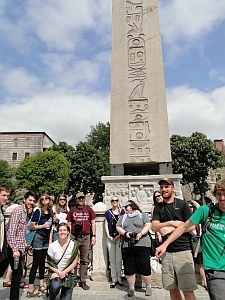
Another emperor to adorn the Hippodrome
was Theodosius the Great, who in 390 brought an obelisk from Egypt and
erected it inside the racing track. Carved from pink granite, it was
originally erected at the Temple of Karnak in Luxor during the reign of
Tuthmosis III in about 1490 BC. Theodosius had the obelisk cut into three
pieces and brought to Constantinople. Only the top section survives, and
it stands today where Theodosius placed it, on a marble pedestal. The
obelisk has survived nearly 3,500 years in astonishingly good condition.
|
|
 To raise
the image of his new capital, Constantine and his successors, especially
Theodosius the Great, brought works of art from all over the empire to
adorn it. The monuments were set up in the middle of the Hippodrome, the
spina. Among these was the Tripod of Plataea, now known as the Serpent
Column, cast to celebrate the victory of the Greeks over the Persians
during the Persian Wars in the 5th century BC. Constantine ordered the
Tripod to be moved from the Temple of Apollo at Delphi, and set in middle
of the Hippodrome. The top was adorned with a golden bowl supported by
three serpent heads. The bowl was destroyed or stolen during the Fourth
Crusade. To raise
the image of his new capital, Constantine and his successors, especially
Theodosius the Great, brought works of art from all over the empire to
adorn it. The monuments were set up in the middle of the Hippodrome, the
spina. Among these was the Tripod of Plataea, now known as the Serpent
Column, cast to celebrate the victory of the Greeks over the Persians
during the Persian Wars in the 5th century BC. Constantine ordered the
Tripod to be moved from the Temple of Apollo at Delphi, and set in middle
of the Hippodrome. The top was adorned with a golden bowl supported by
three serpent heads. The bowl was destroyed or stolen during the Fourth
Crusade. |
|
|
 The releif showing how the way the
Obelisk was erected is divided in two
sections. When the huge one piece stone, the obelisk was laying on its
side, those who were in charge of erecting it looked tiny in proportion of
the stone. After the obelisk was erected, the accomplishment was
symbolized by showing the size of the man as big as the huge stone.
The releif showing how the way the
Obelisk was erected is divided in two
sections. When the huge one piece stone, the obelisk was laying on its
side, those who were in charge of erecting it looked tiny in proportion of
the stone. After the obelisk was erected, the accomplishment was
symbolized by showing the size of the man as big as the huge stone.
After the hippodrome we walked across the street to the Blue Mosque. The
cascading domes were breath taking. Quickl all of our cameras got
stuck on our noses to take the best picture to capture the wonder of
architecture of the 17th Century.
There was a long line to go in the mosque. When we went in the mosque we
sat around Meli to listen to the story of the Sultan who wanted to
immortalize his fame in this monumental building.
|
  |
 |
 
 |
 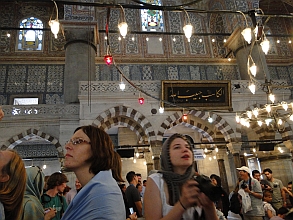
 |
Having tea had become the ritual of our
group. So before we visited Aya Sophia we had one more, our last tea
ritual.

|
 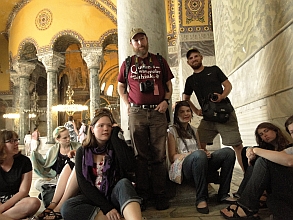
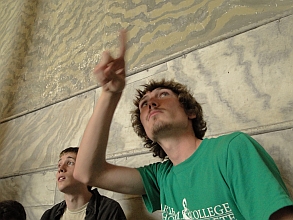
Hillary and Jacob gave us the last 2
presentations. Hillary had an excellent presentation on Aya Sophia and
Jacob, sitting under the marbles which inspired the artists taught us
about marbling in the Ottoman Art. |
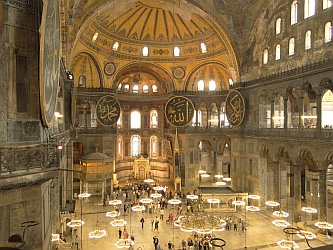 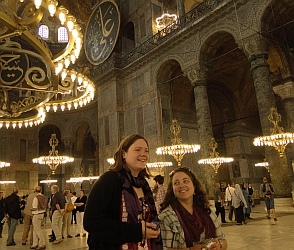
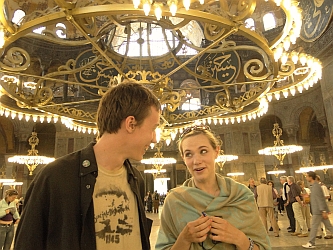
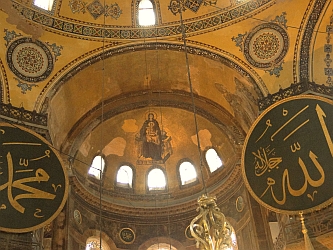 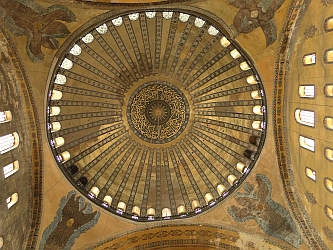 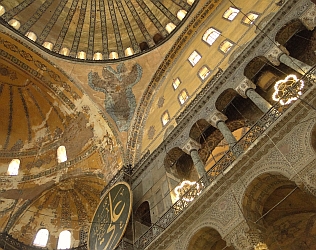
 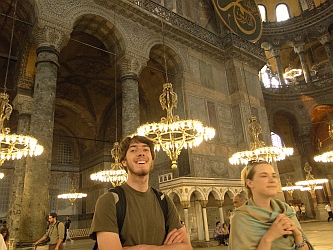
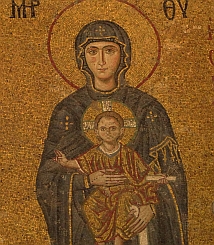
Many of the students had studied Aya
Sophia in their art classes. But they said no pictures and no words can do
justice to the
grandeur of this 1500 year old superb building. |

We have been together for 23 days. for
some of the students who had already graduated this was not just the last
meal of the tour but
also their last Earlham function at least for a while. It was a very
emotional evening. Every one promised to staying touch.
Time will show if our paths will cross again.
 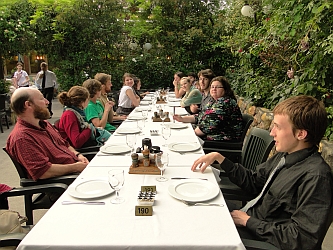
Melitour Home Page
Earlham
2011 Journal
Table of content
DEPARTURE |




























 Today is the last day
of our wonderful tour. We want to end the tour with a grand finale!! We
started at 09:15 to give every one a little longer time to sleep in. We
walked up the road along the tram way to the Sultan Ahmet Square. The tram
that we have used several times was running along a huge 500 year old
plain tree which was right in the middle of the busy road which is one of
the main arteries of Istanbul road system. hMeli told the story of why the
plain trees were so important in the Ottoman history: The Ottoman Sultan's
used to give a bag of gold to every woman who had a baby. The ceremonies
were held every Friday since the beginning of the Empire in 1299 AD.
Today is the last day
of our wonderful tour. We want to end the tour with a grand finale!! We
started at 09:15 to give every one a little longer time to sleep in. We
walked up the road along the tram way to the Sultan Ahmet Square. The tram
that we have used several times was running along a huge 500 year old
plain tree which was right in the middle of the busy road which is one of
the main arteries of Istanbul road system. hMeli told the story of why the
plain trees were so important in the Ottoman history: The Ottoman Sultan's
used to give a bag of gold to every woman who had a baby. The ceremonies
were held every Friday since the beginning of the Empire in 1299 AD. One day, a woman
who did not have a baby in her arms got in line with the mothers with
their new born babies. The Sultan was surprised to see that this woman was
there but had no child. When it was her turn, the sultan asked her why she
was here. The woman replied," your highness I can not have a baby, but I
have planted a plain tree and I promise you I will take care of this tree
as well as a mother will take care of her baby. " The Sultan liked the
idea and awarded the woman with a bag of gold just like he would have done
a mother. since then the plain trees became imperial trees and they were
always protected.
One day, a woman
who did not have a baby in her arms got in line with the mothers with
their new born babies. The Sultan was surprised to see that this woman was
there but had no child. When it was her turn, the sultan asked her why she
was here. The woman replied," your highness I can not have a baby, but I
have planted a plain tree and I promise you I will take care of this tree
as well as a mother will take care of her baby. " The Sultan liked the
idea and awarded the woman with a bag of gold just like he would have done
a mother. since then the plain trees became imperial trees and they were
always protected. Our
first stop in the Byzantine Hippodrome was in front of the Kaiser
William's fountain. when the Prussians and the Ottomans declared alliance,
William visited the capital of the Ottoman Empire and in the Hippodrome
this fountain was built to immortalize the friendship of the two emperors.
The Tugra of the Sultan and the code of arm of William were
decorating the golden dome of the fountain.
Our
first stop in the Byzantine Hippodrome was in front of the Kaiser
William's fountain. when the Prussians and the Ottomans declared alliance,
William visited the capital of the Ottoman Empire and in the Hippodrome
this fountain was built to immortalize the friendship of the two emperors.
The Tugra of the Sultan and the code of arm of William were
decorating the golden dome of the fountain.


 To raise
the image of his new capital, Constantine and his successors, especially
Theodosius the Great, brought works of art from all over the empire to
adorn it. The monuments were set up in the middle of the Hippodrome, the
spina. Among these was the Tripod of Plataea, now known as the Serpent
Column, cast to celebrate the victory of the Greeks over the Persians
during the Persian Wars in the 5th century BC. Constantine ordered the
Tripod to be moved from the Temple of Apollo at Delphi, and set in middle
of the Hippodrome. The top was adorned with a golden bowl supported by
three serpent heads. The bowl was destroyed or stolen during the Fourth
Crusade.
To raise
the image of his new capital, Constantine and his successors, especially
Theodosius the Great, brought works of art from all over the empire to
adorn it. The monuments were set up in the middle of the Hippodrome, the
spina. Among these was the Tripod of Plataea, now known as the Serpent
Column, cast to celebrate the victory of the Greeks over the Persians
during the Persian Wars in the 5th century BC. Constantine ordered the
Tripod to be moved from the Temple of Apollo at Delphi, and set in middle
of the Hippodrome. The top was adorned with a golden bowl supported by
three serpent heads. The bowl was destroyed or stolen during the Fourth
Crusade. The releif showing how the way the
The releif showing how the way the